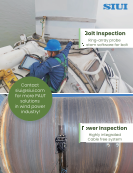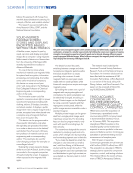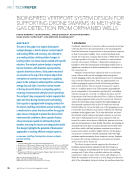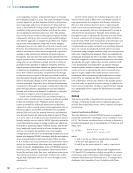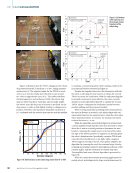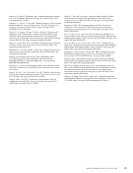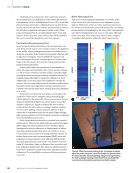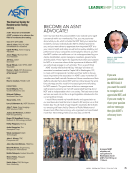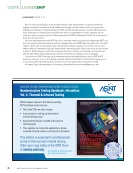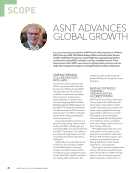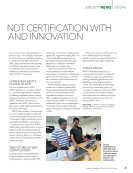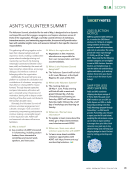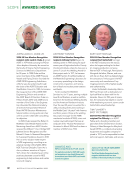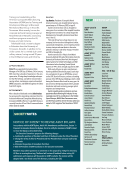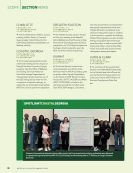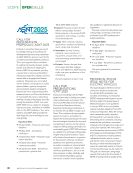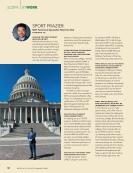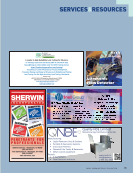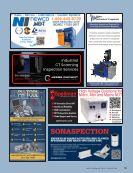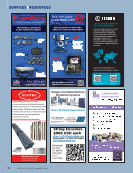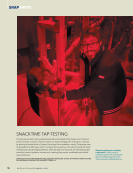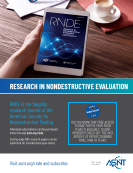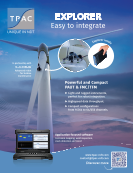28. Sterling, E., and E. McCreless. 2006.
“Adaptations in the Aye-aye: A Review.” In
Lemurs. Boston, MA: Springer. https://doi.
org/10.1007/978-0-387-34586-4_8.
29. Perry, G. H., D. Reeves, P. Melsted, A. Ratan,
W. Miller, K. Michelini, E. E. Louis, et al. 2012.
“A genome sequence resource for the aye-aye
(Daubentonia madagascariensis), a nocturnal
lemur from Madagascar.” Genome Biology
and Evolution. 4 (2): 126–135. https://doi.
org/10.1093/gbe/evr132.
30. Kaufman, J. A., E. T. Ahrens, D. H. Laidlaw,
S. Zhang, and J. M. Allman. 2005. “Anatom-
ical analysis of an aye-aye brain (Dauben-
tonia madagascariensis, primates: Prosimii)
combining histology, structural magnetic reso-
nance imaging, and diffusion-tensor imaging.”
Anatomical Record. Part A, Discoveries in Molec-
ular, Cellular, and Evolutionary Biology 287A (1):
1026–37. https://doi.org/10.1002/ar.a.20264.
31. Coleman, M. N., and C. F. Ross. 2004.
“Primate auditory diversity and its influence on
hearing performance.” Anatomical Record. Part
A, Discoveries in Molecular, Cellular, and Evolu-
tionary Biology 281A (1): 1123–37. https://doi.
org/10.1002/ar.a.20118.
32. Ramsier, M. A., and N. J. Dominy. 2012.
“Receiver bias and the acoustic ecology of
aye-ayes (Daubentonia madagascariensis).”
Communicative &Integrative Biology 5 (6):
637–40. https://doi.org/10.4161/cib.21509.
33. Hartstone‐Rose, A., E. Dickinson, M. L.
Boettcher, and A. Herrel. 2020. “A primate with
a Panda’s thumb: The anatomy of the pseudo-
thumb of Daubentonia madagascariensis,” Am
J Phys Anthropol 171. https://doi.org/10.1002/
ajpa.23936.
34. Nemati, H., and E. Dehghan-Niri. January
2023. “Biomimetic investigation of the impact of
the ear canal on the acoustic field sensitivity of
aye-ayes.” Applied Acoustics 202:109171. https://
doi.org/10.1016/j.apacoust.2022.109171.
35. Nemati, H., and E. Dehghan-Niri. 2020.
“The acoustic near-field measurement of
aye-ayes’ biological auditory system utilizing a
biomimetic robotic tap-scanning.” Bioinspira-
tion &Biomimetics 15 (5): 056003. https://doi.
org/10.1088/1748-3190/ab98de.
36. Masurkar, N., J. Kang, H. Nemati, and
E. Dehghan-Niri. December 2023. “Aye-aye
middle finger kinematic modeling and motion
tracking during tap-scanning.” Biomimetic Intel-
ligence and Robotics 3 (4): 100134. https://doi.
org/10.1016/j.birob.2023.100134.
37. Hsu, D. K., J. J. Peters, and D. J. Barnard.
2004. “Development of fieldable systems for
inspecting aircraft composite structures.” In Key
Engineering Materials, 1845–1851. Trans Tech
Publications Ltd. https://doi.org/10.4028/www.
scientific.net/KEM.270-273.1845.
38. Barnard, D. J., J. J. Peters, and D. K. Hsu.
2001. “Development of a magnetic CAM for
the computer aided tap test system.” In AIP
Conference Proceedings, 1966–1971. https://doi.
org/10.1063/1.1373993.
39. Georgeson, G. E., S. Lea, and J. Hansen.
1996. “Electronic tap hammer for composite
damage assessment.” Nondestructive Evaluation
Techniques of Aging Infrastructure and Manu-
facturing, Scottsdale, AZ: 328–38. https://doi.
org/10.1117/12.259107.
40. Oral, I. 2019. “Characterization of damages
in materials by computer-aided tap testing.”
In IOP Conference Series: Materials Science
and Engineering. https://doi.org/10.1088/1757-
899X/707/1/012019.
41. Tishechkin, D. Y. September 2022. “Vibra-
tional communication in insects.” Entomological
Review 102 (6): 737–68. https://doi.org/10.1134/
S001387382206001X.
42. Bignell, D. E., Y. Roisin, and N. Lo, eds.
2011. Biology of Termites: a Modern Synthesis.
Dordrecht: Springer Netherlands. https://doi.
org/10.1007/978-90-481-3977-4.
43. Hager, F. A., K. Krausa, and W. H.
Kirchner. 2019. “Vibrational behavior in
termites (Isoptera).” In Biotremology: Studying
Vibrational Behavior, ed. P. S. M. Hill, R.
Lakes-Harlan, V. Mazzoni, P. M. Narins, M.
Virant-Doberlet, and A. Wessel, 309–327. Cham:
Springer International Publishing. https://doi.
org/10.1007/978-3-030-22293-2_16.
44. Howse, P. E. 1964. “The significance of the
sound produced by the termite Zootermopsis
angusticollis (Hagen).” Animal Behaviour 12
(2–3): 284–300. https://doi.org/10.1016/0003-
3472(64)90015-6.
45. Hager, F. A., and W. H. Kirchner. September
2013. “Vibrational long-distance communica-
tion in the termites macrotermes natalensis
and odontotermes sp.” Journal of Experi-
mental Biology 216 (17): 3249–56. https://doi.
org/10.1242/jeb.086991.
46. Hager, F. A., and W. H. Kirchner. July 2014.
“Directional vibration sensing in the termite
Macrotermes natalensis.” Journal of Experi-
mental Biology 217 (14): 2526–30. https://doi.
org/10.1242/jeb.103184.
47. Röhrig, A., W. H. Kirchner, and R. H.
Leuthold. 1999. “Vibrational alarm communi-
cation in the African fungus-growing termite
genus Macrotermes (Isoptera, Termitidae).”
Insectes Sociaux 46 (1): 71–77. https://doi.
org/10.1007/s000400050115.
48. Delattre, O., J. Šobotník, V. Jandák, J. Synek,
J. Cvacka, ˇ O. Jirícek, ˇ T. Bourguignon, and D.
Sillam-Dussès. May 2019. “Chemical and vibra-
tory signals used in alarm communication in
the termite Reticulitermes flavipes (Rhinotermit-
idae).” Insectes Sociaux 66 (2): 265–72. https://
doi.org/10.1007/s00040-018-00682-9.
49. Evans, T. A., R. Inta, J. C. S. Lai, and M. Lenz.
November 2007. “Foraging vibration signals
attract foragers and identify food size in the
drywood termite, Cryptotermes secundus.”
Insectes Sociaux 54 (4): 374–82. https://doi.
org/10.1007/s00040-007-0958-1.
50. Ke, J., D. D. Laskar, D. Gao, and S. Chen.
2012. “Advanced biorefinery in lower termite-
effect of combined pretreatment during the
chewing process.” Biotechnology for Biofuels 5
(1): 11. https://doi.org/10.1186/1754-6834-5-11.
51. Smeathman, H. 1781. Some account of the
termites, which are found in Africa and other hot
climates. Letter. The Royal Society.
52. Inta, R., J. C. S. Lai, E. W. Fu, and T. A.
Evans. August 2007. “Termites live in a material
world: Exploration of their ability to differentiate
between food sources.” Journal of the Royal
Society, Interface 4 (15): 735–44. https://doi.
org/10.1098/rsif.2007.0223.
53. Auld, B. A. 1973. Acoustic Fields and Waves in
Solids. John Wiley &Sons.
54. Hu, X. 2011. “Biology and reproductive strat-
egies in the subterranean termites (Isoptera:
Rhinotermitidae).” in Recent Advances in Ento-
mological: 213–226. Springer Berlin Heidelberg.
https://doi.org/10.1007/978-3-642-17815-3_12.
55. Inta, R., T. A. Evans, J. C. S. Lai, and M.
Lenz. 2007. “What do vibrations have to do with
termites’ food choice?” Acoust Aust. 35: 73–77.
https://www.researchgate.net/publication/
261504371.
56. Evans, T. A., J. C. S. Lai, E. Toledano, L.
McDowall, S. Rakotonarivo, and M. Lenz. 2005.
“Termites assess wood size by using vibration
signals.” Proc. Natl. Acad. Sci. USA. https://doi.
org/10.1073/pnas.0408649102.
57. Cervený, J., S. Begall, P. Koubek, P. Nováková,
and H. Burda. June 2011. “Directional preference
may enhance hunting accuracy in foraging
foxes.” Biology Letters 7 (3): 355–57. https://doi.
org/10.1098/rsbl.2010.1145.
58. Malkemper, E. P. 2014. “The sensory biology
of the red fox – hearing, vision, magnetorecep-
tion.” Dissertation. Universität Duisburg-Essen.
59. Dahlgren, S. S., and B. Gjerde. September
2010. “The red fox (Vulpes vulpes) and the
arctic fox (Vulpes lagopus) are definitive
hosts of Sarcocystis alces and Sarcocystis
hjorti from moose (Alces alces).” Parasitology
137 (10): 1547–57. https://doi.org/10.1017/
S0031182010000399.
60. Yan, Y., Y. Shen, X. Cui, and Y. Hu. December
2018. “Localization of multiple leak sources
using acoustic emission sensors based on
MUSIC algorithm and wavelet packet analysis.”
IEEE Sensors Journal 18 (23): 9812–20. https://
doi.org/10.1109/JSEN.2018.2871720.
61. Liu, C., Y. Li, L. Fang, and M. Xu. March 2017.
“Experimental study on a de-noising system for
gas and oil pipelines based on an acoustic leak
detection and location method.” International
Journal of Pressure Vessels and Piping 151:20–34.
https://doi.org/10.1016/j.ijpvp.2017.02.001.
62. Li, J., Y. Li, X. Huang, J. Ren, H. Feng, Y.
Zhang, and X. Yang. April 2021. “High-sensitivity
gas leak detection sensor based on a compact
microphone array.” Measurement 174:109017.
https://doi.org/10.1016/j.measurement
.2021.109017.
A P R I L 2 0 2 5 • M AT E R I A L S E V A L U AT I O N 33
“Adaptations in the Aye-aye: A Review.” In
Lemurs. Boston, MA: Springer. https://doi.
org/10.1007/978-0-387-34586-4_8.
29. Perry, G. H., D. Reeves, P. Melsted, A. Ratan,
W. Miller, K. Michelini, E. E. Louis, et al. 2012.
“A genome sequence resource for the aye-aye
(Daubentonia madagascariensis), a nocturnal
lemur from Madagascar.” Genome Biology
and Evolution. 4 (2): 126–135. https://doi.
org/10.1093/gbe/evr132.
30. Kaufman, J. A., E. T. Ahrens, D. H. Laidlaw,
S. Zhang, and J. M. Allman. 2005. “Anatom-
ical analysis of an aye-aye brain (Dauben-
tonia madagascariensis, primates: Prosimii)
combining histology, structural magnetic reso-
nance imaging, and diffusion-tensor imaging.”
Anatomical Record. Part A, Discoveries in Molec-
ular, Cellular, and Evolutionary Biology 287A (1):
1026–37. https://doi.org/10.1002/ar.a.20264.
31. Coleman, M. N., and C. F. Ross. 2004.
“Primate auditory diversity and its influence on
hearing performance.” Anatomical Record. Part
A, Discoveries in Molecular, Cellular, and Evolu-
tionary Biology 281A (1): 1123–37. https://doi.
org/10.1002/ar.a.20118.
32. Ramsier, M. A., and N. J. Dominy. 2012.
“Receiver bias and the acoustic ecology of
aye-ayes (Daubentonia madagascariensis).”
Communicative &Integrative Biology 5 (6):
637–40. https://doi.org/10.4161/cib.21509.
33. Hartstone‐Rose, A., E. Dickinson, M. L.
Boettcher, and A. Herrel. 2020. “A primate with
a Panda’s thumb: The anatomy of the pseudo-
thumb of Daubentonia madagascariensis,” Am
J Phys Anthropol 171. https://doi.org/10.1002/
ajpa.23936.
34. Nemati, H., and E. Dehghan-Niri. January
2023. “Biomimetic investigation of the impact of
the ear canal on the acoustic field sensitivity of
aye-ayes.” Applied Acoustics 202:109171. https://
doi.org/10.1016/j.apacoust.2022.109171.
35. Nemati, H., and E. Dehghan-Niri. 2020.
“The acoustic near-field measurement of
aye-ayes’ biological auditory system utilizing a
biomimetic robotic tap-scanning.” Bioinspira-
tion &Biomimetics 15 (5): 056003. https://doi.
org/10.1088/1748-3190/ab98de.
36. Masurkar, N., J. Kang, H. Nemati, and
E. Dehghan-Niri. December 2023. “Aye-aye
middle finger kinematic modeling and motion
tracking during tap-scanning.” Biomimetic Intel-
ligence and Robotics 3 (4): 100134. https://doi.
org/10.1016/j.birob.2023.100134.
37. Hsu, D. K., J. J. Peters, and D. J. Barnard.
2004. “Development of fieldable systems for
inspecting aircraft composite structures.” In Key
Engineering Materials, 1845–1851. Trans Tech
Publications Ltd. https://doi.org/10.4028/www.
scientific.net/KEM.270-273.1845.
38. Barnard, D. J., J. J. Peters, and D. K. Hsu.
2001. “Development of a magnetic CAM for
the computer aided tap test system.” In AIP
Conference Proceedings, 1966–1971. https://doi.
org/10.1063/1.1373993.
39. Georgeson, G. E., S. Lea, and J. Hansen.
1996. “Electronic tap hammer for composite
damage assessment.” Nondestructive Evaluation
Techniques of Aging Infrastructure and Manu-
facturing, Scottsdale, AZ: 328–38. https://doi.
org/10.1117/12.259107.
40. Oral, I. 2019. “Characterization of damages
in materials by computer-aided tap testing.”
In IOP Conference Series: Materials Science
and Engineering. https://doi.org/10.1088/1757-
899X/707/1/012019.
41. Tishechkin, D. Y. September 2022. “Vibra-
tional communication in insects.” Entomological
Review 102 (6): 737–68. https://doi.org/10.1134/
S001387382206001X.
42. Bignell, D. E., Y. Roisin, and N. Lo, eds.
2011. Biology of Termites: a Modern Synthesis.
Dordrecht: Springer Netherlands. https://doi.
org/10.1007/978-90-481-3977-4.
43. Hager, F. A., K. Krausa, and W. H.
Kirchner. 2019. “Vibrational behavior in
termites (Isoptera).” In Biotremology: Studying
Vibrational Behavior, ed. P. S. M. Hill, R.
Lakes-Harlan, V. Mazzoni, P. M. Narins, M.
Virant-Doberlet, and A. Wessel, 309–327. Cham:
Springer International Publishing. https://doi.
org/10.1007/978-3-030-22293-2_16.
44. Howse, P. E. 1964. “The significance of the
sound produced by the termite Zootermopsis
angusticollis (Hagen).” Animal Behaviour 12
(2–3): 284–300. https://doi.org/10.1016/0003-
3472(64)90015-6.
45. Hager, F. A., and W. H. Kirchner. September
2013. “Vibrational long-distance communica-
tion in the termites macrotermes natalensis
and odontotermes sp.” Journal of Experi-
mental Biology 216 (17): 3249–56. https://doi.
org/10.1242/jeb.086991.
46. Hager, F. A., and W. H. Kirchner. July 2014.
“Directional vibration sensing in the termite
Macrotermes natalensis.” Journal of Experi-
mental Biology 217 (14): 2526–30. https://doi.
org/10.1242/jeb.103184.
47. Röhrig, A., W. H. Kirchner, and R. H.
Leuthold. 1999. “Vibrational alarm communi-
cation in the African fungus-growing termite
genus Macrotermes (Isoptera, Termitidae).”
Insectes Sociaux 46 (1): 71–77. https://doi.
org/10.1007/s000400050115.
48. Delattre, O., J. Šobotník, V. Jandák, J. Synek,
J. Cvacka, ˇ O. Jirícek, ˇ T. Bourguignon, and D.
Sillam-Dussès. May 2019. “Chemical and vibra-
tory signals used in alarm communication in
the termite Reticulitermes flavipes (Rhinotermit-
idae).” Insectes Sociaux 66 (2): 265–72. https://
doi.org/10.1007/s00040-018-00682-9.
49. Evans, T. A., R. Inta, J. C. S. Lai, and M. Lenz.
November 2007. “Foraging vibration signals
attract foragers and identify food size in the
drywood termite, Cryptotermes secundus.”
Insectes Sociaux 54 (4): 374–82. https://doi.
org/10.1007/s00040-007-0958-1.
50. Ke, J., D. D. Laskar, D. Gao, and S. Chen.
2012. “Advanced biorefinery in lower termite-
effect of combined pretreatment during the
chewing process.” Biotechnology for Biofuels 5
(1): 11. https://doi.org/10.1186/1754-6834-5-11.
51. Smeathman, H. 1781. Some account of the
termites, which are found in Africa and other hot
climates. Letter. The Royal Society.
52. Inta, R., J. C. S. Lai, E. W. Fu, and T. A.
Evans. August 2007. “Termites live in a material
world: Exploration of their ability to differentiate
between food sources.” Journal of the Royal
Society, Interface 4 (15): 735–44. https://doi.
org/10.1098/rsif.2007.0223.
53. Auld, B. A. 1973. Acoustic Fields and Waves in
Solids. John Wiley &Sons.
54. Hu, X. 2011. “Biology and reproductive strat-
egies in the subterranean termites (Isoptera:
Rhinotermitidae).” in Recent Advances in Ento-
mological: 213–226. Springer Berlin Heidelberg.
https://doi.org/10.1007/978-3-642-17815-3_12.
55. Inta, R., T. A. Evans, J. C. S. Lai, and M.
Lenz. 2007. “What do vibrations have to do with
termites’ food choice?” Acoust Aust. 35: 73–77.
https://www.researchgate.net/publication/
261504371.
56. Evans, T. A., J. C. S. Lai, E. Toledano, L.
McDowall, S. Rakotonarivo, and M. Lenz. 2005.
“Termites assess wood size by using vibration
signals.” Proc. Natl. Acad. Sci. USA. https://doi.
org/10.1073/pnas.0408649102.
57. Cervený, J., S. Begall, P. Koubek, P. Nováková,
and H. Burda. June 2011. “Directional preference
may enhance hunting accuracy in foraging
foxes.” Biology Letters 7 (3): 355–57. https://doi.
org/10.1098/rsbl.2010.1145.
58. Malkemper, E. P. 2014. “The sensory biology
of the red fox – hearing, vision, magnetorecep-
tion.” Dissertation. Universität Duisburg-Essen.
59. Dahlgren, S. S., and B. Gjerde. September
2010. “The red fox (Vulpes vulpes) and the
arctic fox (Vulpes lagopus) are definitive
hosts of Sarcocystis alces and Sarcocystis
hjorti from moose (Alces alces).” Parasitology
137 (10): 1547–57. https://doi.org/10.1017/
S0031182010000399.
60. Yan, Y., Y. Shen, X. Cui, and Y. Hu. December
2018. “Localization of multiple leak sources
using acoustic emission sensors based on
MUSIC algorithm and wavelet packet analysis.”
IEEE Sensors Journal 18 (23): 9812–20. https://
doi.org/10.1109/JSEN.2018.2871720.
61. Liu, C., Y. Li, L. Fang, and M. Xu. March 2017.
“Experimental study on a de-noising system for
gas and oil pipelines based on an acoustic leak
detection and location method.” International
Journal of Pressure Vessels and Piping 151:20–34.
https://doi.org/10.1016/j.ijpvp.2017.02.001.
62. Li, J., Y. Li, X. Huang, J. Ren, H. Feng, Y.
Zhang, and X. Yang. April 2021. “High-sensitivity
gas leak detection sensor based on a compact
microphone array.” Measurement 174:109017.
https://doi.org/10.1016/j.measurement
.2021.109017.
A P R I L 2 0 2 5 • M AT E R I A L S E V A L U AT I O N 33





